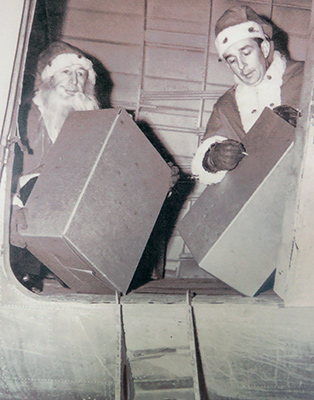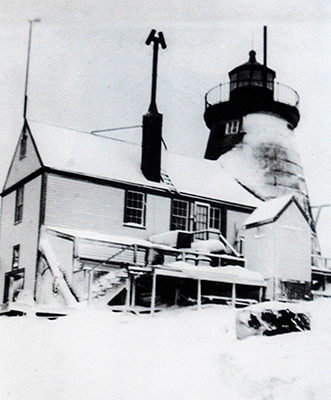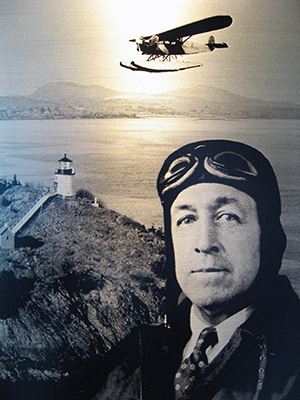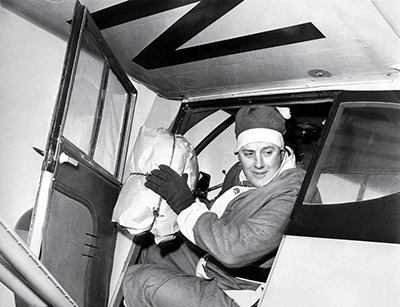Lofty Words for the Flying Santa

(Maine Lighthouse Museum photo)
Following the first time that Flying Santa – the legendary Captain Bill Wincapaw, took to the air to show his appreciation to Penobscot Bay area lighthouse keepers by dropping gift bundles on Christmas Day, December 25, 1929, the Rockland Courier Gazette newspaper thereafter faithfully mentioned the heartwarming exploits of the Flying Santa during the holiday season.
The popular newspaper did the same for renowned author and historian Edward Rowe Snow who was involved with helping Captain Wincapaw and his son Bill Wincapaw, Jr. from 1936 to 1947. In December 1947, Edward Rowe Snow assumed the mantle of Flying Santa following the tragic death of Captain Bill Wincapaw earlier in the year. Snow served as the Flying Santa through 1980. The Flying Santa trips were expanded to include most lighthouses along the Maine coast, as well as others throughout New England and beyond.
We thought the reader might enjoy the following selected mentions of the Flying Santa, which appeared in the Rockland Courier Gazette newspaper during the years 1930, 1936 and 1944.
Rockland Courier Gazette, December 25, 1930
Captain William H. Wincapaw to Play Santa on a Christmas Trip without a Parallel
(Excerpted)
“For the first time in history Christmas greetings from the City of Rockland will be extended to all of Uncle Sam’s light stations in the Penobscot Bay district.
“With a tardy sun only a few hours high in the eastern heavens, an airplane, piloted by Captain William H. Wincapaw, manager of the Rockland Airport, will be winging its way along the coast and over the islands wherever stands a beacon designed for the mariner’s safety.

(American Lighthouse Foundation photo)
“Flying low over those isolated stations Captain Wincapaw and his companion, Alan L. Bird, the well-known Rockland attorney, will let fall a bundle containing newspapers, magazines, and conspicuously tagged ‘Christmas Greetings from the City of Rockland.’
“The flight made by Captain Wincapaw and Mr. Bird will total approximately 160 miles. If the conditions are favorable, Captain Wincapaw will visit Mount Desert Rock, 34 miles from the mainland; otherwise, Monhegan 28 miles out will be the farthest journey seaward.
“Here is the list of light stations scheduled for the airplane’s Christmas tour: Saddleback, Isle au Haut, Mark Island, Goose Rocks, Eagle Island, Pumpkin Island, Heron Neck, Matinicus Rock, Two Bush, Whitehead, Owl’s Head, Rockland Breakwater, Brown’s Head, Indian Island, Negro Island (renamed Curtis Island in 1934), Grindle Point, Dice Head, Fort Point, Tenants Harbor, Marshall Point, Manana (fog signal station), Franklin Island and Swan’s Island.
“It is difficult to picture a more interesting trip than the one thus outlined, and which has certainly never had a parallel in New England.”
Rockland Courier Gazette, December 22, 1936
Sky Santa Claus Headed for Maine Coast
(Excerpted)

(Maine Lighthouse Museum plaque)
“Santa Claus, who scorns reindeer and flies with the swiftness of a bird, will swoop down out of the skies to drop tidings of Christmas cheer at Lighthouses, Coast Guard Stations and lonely islands.
“Captain Wincapaw has a deep affection for these lighthouse keepers. Christmas Day, 1929, he loaded an amphibian with 12 bundles and set out to drop these at the lights near Rockland. This practice has continued each year since, and the Captain vows that it will be done every Christmas as long as he flies and after that, Bill Jr. is pledged to carry on the aerial Santa tradition.
“From year to year these stalwart Americans (lighthouse keepers and their families) look forward to Christmas. They know that it brings Captain Bill and his famous plane. They scan the horizon for hours until he comes. They rush outside, wave their arms in appreciation. The children of the islands know they have seen Santa Claus.”
Rockland Courier Gazette, December 19, 1944
Snow Acts as Santa Claus

(Photo courtesy of Dolly Snow Bicknell)
“The Christmas spirit which takes into account those lonely guardians of our coast – the lightkeepers and Coast Guard stations – was again in evidence Sunday and Monday when Edward Rowe Snow of Boston played the role of sky Santa Claus, flying hundreds of miles along the New England coast, laden with Christmas gifts, which were dropped not only for the lightkeepers but occupants of isolated harbor and places where troops are stationed. A great deal of credit goes to Captain William H. Wincapaw, who originated this thoughtful plan, and to Edward Rowe Snow who has gone to the pains of perpetuating it.”